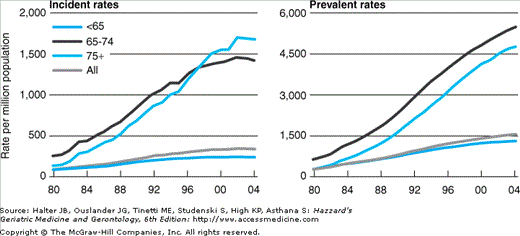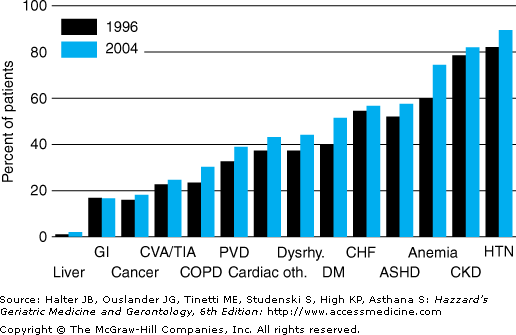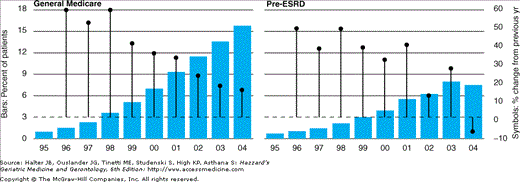Definition
End-stage renal disease (ESRD) or kidney failure has been defined as having kidney function less than 15 mL/min/1.73 m2. Kidney failure may be caused by progression of a chronic nephropathy or by acute kidney injury (AKI). Kidney failure is associated with the inability to excrete waste products, control serum electrolytes, handle the daily dietary and metabolic acid load, and maintain fluid balance. In addition, kidney failure causes inadequate production of erythropoietin, deranged calcium and phosphorous metabolism, high blood pressure, and accelerated progression of cardiovascular disease. Uremia is the term used to describe the symptoms or symptom complex attributable to advanced kidney failure or ESRD. Most chronic nephropathies demonstrate inexorable progression to kidney failure. In general, there is a straight line relationship between the decrement in kidney function over time when the kidney function is plotted longitudinally. The rates of decline in kidney function vary by underlying nephropathy, by severity of hypertension and proteinuria, by modifying factors, and between individuals. Historically, the rate of decline could be estimated as 7 to 10 mL/min/year in those with untreated chronic nephropathies such as diabetic nephropathy. However, chronic nephropathies have similar effects on electrolyte homeostasis, causes of progressive decline in function, and manifestations of kidney failure so that classification by severity permits a better understanding of underlying routes to progression, symptoms, and hopefully, treatments of chronic kidney disease (CKD). In parts of the world with access to dialysis and kidney transplantation, renal replacement therapy (RRT) has been thought to be necessary when the glomerular filtration rate (GFR) decreases to less than 15 mL/min. “Kidney damage” has been defined as structural or functional abnormalities of the kidney, initially without decreased GFR, which over time can lead to decreased GFR. Markers of kidney damage include abnormalities in the composition of the blood or urine, or abnormalities in imaging tests. Proteinuria as a marker of kidney damage has been studied most thoroughly. CKD is the term used to describe patients with a chronic decrease in GFR. There are different levels of CKD, and these levels have underpinned an international classification system (Table 87-1). It has been proposed that advanced CKD (GFR estimated <15mL/min/1.73m2) be classified as CKD Stage 5 with a suffix to classify the treatment modality. For example, a person treated by hemodialysis would be characterized as CKD Stage 5-D.
STAGE | DESCRIPTION | GFR mL/min/1.73 m2 | RELATED TERMS | CLASSIFICATION BY TREATMENT |
|---|---|---|---|---|
1 | Kidney damage with normal or ↑ GFR | ≥90 | Albuminuria, proteinuria, hematuria | |
2 | Kidney damage with mild ↓GFR | 60–89 | Albuminuria, proteinuria, hematuria | |
3 | Moderate ↓GFR | 30–59 | Chronic renal insufficiency | |
4 | Severe ↓GFR | 15–29 | Chronic renal insufficiency, pre-ESRD | |
5 | Kidney Failure | <15 (or dialysis) | Renal failure, uremia, end-stage renal disease | D if dialysis T if kidney transplant recipient |
Epidemiology
The prevalence of kidney failure is increasing rapidly worldwide; the projections are that the number of patients with kidney failure will double in the next 10 to 15 years. However, this is just the tip of the iceberg. Estimates are that there are 30 times as many people with CKD as compared to kidney failure. Approximately 14.7% of the U.S. adult population is thought to have some form of CKD. The majority of those with CKD Stage 1 and Stage 2 may not even be aware of their kidney disease. Nonmodifiable risk factors are important for risk stratification and for understanding the pathophysiology of CKD progression (Table 87-2). African-American patients with diabetes have a two- to threefold higher risk of developing kidney failure compared to white patients. Modifiable risk factors are important for both understanding disease progression and as a possible option for prevention or therapy. For example, the heavy consumption of analgesics has been associated with the development of kidney failure. The number of patients who develop kidney disease and at risk for developing kidney disease will increase with the increasing prevalence of diabetes and the aging of the population.
The burgeoning number of elderly with kidney failure has been caused by an increased incidence of kidney failure, greater access to RRT, and improved survival of both dialysis patients and kidney transplant recipients. The majority of patients in the United States receiving hemodialysis are aged 65 years and older and the proportion of older patients undergoing hemodialysis is rapidly increasing (Figure 87-1). Hence, the growth of the ESRD population has been driven by those patients older than 65 years. This has been a worldwide phenomenon with a sevenfold increase in the rate of incident dialysis patients older than 75 years over the past two decades in Canada. Similar rates of increase of kidney failure in the elderly have been noted in Europe and Japan with a 10-fold increase in octogenarian hemodialysis patients in Japan. Indeed, the very recent marked increase in incidence of end-stage kidney failure documented by renal registries suggests that this spike of disease has been driven by the increased access to RRT. Older and sicker patients have been referred for hemodialysis in Asia, Australia, Europe, and North America as a result of perceived improvements in quality of life on dialysis, as well as economic and cultural factors. Once referred for kidney failure, older patients have been surviving longer with RRT as dialysis adequacy has increased and kidney transplant outcomes have improved. As a result of improvements in technology and greater access to dialysis, the increased prevalence of older adults undergoing RRT generally mirrors the aging trend of the general population.
Figure 87-1.
Incident and prevalence rates for ESRD patients aged 75 yrs and older from 1980 to 2004. Rates adjusted for gender and race. (2006 Annual Data Report: Atlas of End-Stage Renal Disease in the United States. Bethesda, MD: National Institutes of Health, National Institute of Diabetes and Digestive and Kidney Diseases; 2006.)
AKI has been defined as an abrupt decrease in kidney function. This decrement in kidney function is reflected by an increase of serum creatinine from baseline of at least 50% often in the setting of reduced urine output. More than 50% of patients with AKI are older than 60 years of age. The elderly are thought to be predisposed to AKI owing to a reduced GFR, comorbid illness, and use of medications such as nonsteroidal anti-inflammatories and angiotensin-converting enzyme inhibitors. AKI may occur in elderly patients both in the outpatient or inpatient setting. Obstruction from prostatic hypertrophy, volume depletion, and medications are prominent causes of AKI among the community-dwelling elderly. In the hospital setting, AKI may occur in up to 25% of critically ill patients and has been associated with a marked increase in mortality. Among hospitalized patients, AKI often arises from acute tubular necrosis or acute interstitial nephritis, although AKI merits a thorough evaluation for reversible causes. At present, the care of patients with AKI has been supportive care with acute dialysis and avoidance of further kidney injury from nephrotoxins. The indications for initiation of emergent or acute dialysis therapy in the elderly population vary little from younger patients (Table 87-3). The prognosis for survivors of AKI depends on severity of illness, chronic health conditions, length of time requiring dialysis, and preexisting kidney disease. A majority of patients who survive the initial insult of acute renal failure caused by acute tubular necrosis requiring dialysis will recover renal function and have adequate long-term kidney function. A large randomized trial of AKI in the hospitalized patient will determine the optimal frequency and intensity of dialysis following kidney failure caused by AKI in both young and old critically ill patients.
Refractory |
Progressive fluid overload |
Hyperkalemia |
Metabolic acidosis |
Uremia |
Nausea, vomiting, poor appetite |
Altered mental status (encephalopathy) |
Bleeding diathesis (uremic platelet dysfunction) |
Pericarditis |
Presentation
The most common reported causes of ESRD in the elderly population have been shown to diabetes and hypertension in the United States and worldwide (Figure 87-2). The high proportion of kidney failure diagnosed as nephropathy as a result of diabetes and hypertension maybe in part because of a hesitance to perform a kidney biopsy in elderly patients in the face of usual indications such as nephrotic range proteinuria or unexplained renal failure. It may also be that age-related changes seen in many kidneys contribute to the disease-related changes of diabetes and hypertension to cause kidney failure in the elderly. However, several disease processes including primary kidney and vascular diseases present in older patients with kidney failure. Minimal change disease, usually more associated with a pediatric population, has a second peak in incidence during the sixth decade of life. The declining immunity associated with aging may also play a role in the second peak in incidence of poststreptococcal glomerulonephritis seen in the elderly. Pauci-immune necrotizing glomerulonephritis is also more common among those older than 65 years. In addition to immune-mediated kidney disease, renovascular disease, a term used to describe arterial sclerosis in the kidney, is more common in older individuals. The presence of a clinically significant narrowing of the renal artery may lead to marked hypertension and kidney failure. Diagnosis involves magnetic resonance angiography, renal ultrasounds with Doppler, or a captopril renogram. The treatment of renal artery stenosis depends on the severity of the lesion and the clinical presentation. Options for treatment include renal angioplasty and stenting, renal bypass surgery, or medical management. The best treatment of renal artery stenosis among the elderly remains controversial with the current literature supporting conservative medical management. When older patients with CKD present with an acute increase in creatinine, they should be evaluated for reversible causes of their kidney failure such as obstruction or volume depletion.
Figure 87-2.
Incident and prevalent rates, by primary diagnosis from 1980 to 2004 for patients aged 75 yrs and older at initiation, and December 31 point prevalent ESRD patients, aged 75 yrs and older. Rates adjusted for age, gender, and race. (2006 Annual Data Report: Atlas of End-Stage Renal Disease in the United States. Bethesda, MD: National Institutes of Health, National Institute of Diabetes and Digestive and Kidney Diseases; 2006.)
Referral of Patients to Nephrology
The geriatrician can influence the outcome of kidney failure with the timing of referral. In the past, physicians would limit access to dialysis and transplantation simply by not sending a patient to a nephrologist. While this still happens widely and is common in certain practices and in parts of the world with more limited health care, many patients should be referred for kidney-targeted therapy. Older patients with kidney failure maybe referred late to nephrologists with resulting poor outcomes. These patients may lose the opportunity to consider conservative therapy and require dialysis. The National Kidney Foundation Kidney Disease Outcomes Quality Initiative (“K/DOQI”) CKD Guidelines advises referral to a nephrologist after diagnosis under the following circumstances: a clinical action plan cannot be prepared based on the stage of the disease, the prescribed evaluation of the patient cannot be carried out, or the recommended treatment cannot be carried out. In general, patients with GFR <30 mL/min/1.73 m2 (CKD Stages 4 and 5) should be referred to a nephrologist. It is difficult to estimate the proportion of late referrals that have been caused by the failure to recognize kidney failure in the elderly.
While most geriatricians may feel comfortable managing CKD and the concomitant metabolic and endocrine derangements, it is important to have nephrology involvement for patient education and preparation for dialysis. As outlined below, older patients with worsening CKD have a wide spectrum of choices for the treatment of kidney failure. It may take some time for the older patient to be educated and accept another chronic illness in the form of CKD, and then time to select a therapeutic approach to the kidney failure. Once therapy has been selected, some of the treatments require lead time prior to the development of an urgent indication for dialysis. For example, the placement of a vascular access may require a referral to a vascular surgeon, vein mapping, and months for fistula maturation and monitoring. A large European Study has demonstrated that late referral was associated with poor outcomes and that outcomes among older patients referred late were significantly worse than younger patients referred late. In many studies of referral timeliness, the cut-point has been arbitrarily set at 3 to 4 months; however, it is likely that this is still too short of a time to optimize the care of the older patient with kidney failure.
Since the access to dialysis and kidney transplantation has been liberalized, there has been a steady shift of the population to not only older patients, but also to those burdened with comorbid disease. In one cohort of adult patients treated with maintenance hemodialysis in the United Kingdom, 90% of patients older than 65 years of age had two or more chronic health conditions. These findings are underscored by data from the 2006 United States Renal Data System, which demonstrate that patients 65 to 74 years of age have the multiple chronic health conditions and that the number of comorbid illnesses has been steady or increased in this population (Figure 87-3). Cardiovascular, musculoskeletal, and neurological problems predominate and adversely affected morbidity, hospitalizations mortality, and quality of life. Given the complexity of managing older patients with a high burden of comorbid disease, the geriatric team has the opportunity to play a crucial role in the care of these patients. The role of the primary care provider for older patient on dialysis or following kidney transplantation varies by local practice patterns and resources. At times, the nephrologist may subsume the role of the geriatric team given the frequent interaction with the patient at the dialysis units or the complexities of immunosuppressant following kidney transplantation. In other instances, geriatricians retain the primary role and nephrologists administer the dialysis in more of a consulting role. Those with advanced CKD have been shown to have gaps in their primary care, diabetes care, and cardiovascular disease care. This has been illustrated by The U.S. Renal Data System (USRDS) data demonstrating worse diabetes care among CKD Stage 4 to 5 patients compared to the general Medicare population as assessed by the performance of screening tests (Figure 87-4). It may be that nephrologists would benefit from targeted geriatric training, or as some propose, that there should be special geriatric dialysis units in order to address these gaps in care.
Figure 87-3.
Comorbid conditions developed in the 2 yrs prior to ESRD initiation. Mean glomerular filtration rate (GFR) at initiation of hemodyalisis by age for incident patients in 1999. (2006 Annual Data Report: Atlas of End-Stage Renal Disease in the United States. Bethesda, MD: National Institutes of Health, National Institute of Diabetes and Digestive and Kidney Diseases; 2006.)
Figure 87-4.
Percent of diabetic patients receiving all four diabetic preventive care tests. General Medicare: patients diagnosed with diabetes in each year, aged 67 yrs and older on December 31 of the diagnosis year, and continuously enrolled in Medicare during the diagnosis year and the previous year. Claims from diagnosis year and the previous year searched for eye examination codes; claims from diagnosis year searched for lipid, HbA1c, and microalbuminuria testing codes. Pre-ESRD: incident patients aged 67 yrs and older at initiation, and with diabetes 1 yr prior to start of ESRD. Eye examinations tracked 2 yrs prior to start of ESRD; lipid, HbA1c, and microalbuminuria testing tracked 1 yr prior to start of ESRD. (2006 Annual Data Report: Atlas of End-Stage Renal Disease in the United States. Bethesda, MD: National Institutes of Health, National Institute of Diabetes and Digestive and Kidney Diseases, 2006.)
Indications for Initiation of Dialysis
The most common symptoms present before initiation of maintenance dialysis in older patients tend to be anorexia, weight loss, fatigue, nausea, and vomiting. The recognition of uremia in the elderly patient, however, may prove more difficult than in the younger patient. Behavioral changes, unexplained dementia, “adult failure to thrive,” unexplained worsening of congestive heart failure, or a change in sense of well-being may represent uremia in the geriatric patient.













